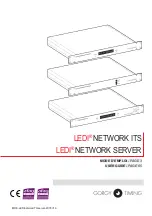
Instruction Manual
28
This client software requires the use of Java 2 (JRE 1.4) to enable features like wheel
mouse support. Sun Microsystems’ Java site, www.java.com, is an excellent resource to
ensure your browser and operating system are updated accordingly.
Native VNC Client
This system implements the VNC protocol, so any off the shelf VNC client can be used.
There are over 17 different VNC clients available and they should all work with this
system. This system automatically detects and makes use of certain extensions to the
basic RFB protocol that is provided by the leading VNC clients. Depending on your
needs, there are several popular freeware, shareware, and commercial VNC clients
available. Contact your system administrator or local software vendor for assistance.
NOTE: Some native VNC clients may require a flag or setting indicating they should use
BGR233 encoding by default. If this flag is not set, you may see a garbled picture and
the client will fail. The Unix versions of VNC require the flag -bgr233. For examples on
using this flag, review the commands in the following section.
SSH Tunnel (with Native VNC client)
If you are using OpenSSH, here is the appropriate Unix command to use, based on the
default settings on a machine at 10.0.0.34:
ssh -f -l admin -L 15900:127.0.0.1:5900 10.0.0.34 sleep 60
vncviewer -bgr233 127.0.0.1::15900
Same command, but using the WAN port:
ssh -f -l admin -L 15900:127.0.0.1:5900 10.0.0.98 sleep 60
vncviewer -bgr233 127.0.0.1::15900
Notes:
• A copy of these commands, with appropriate values filled in for your current system
setting, is provided in the on-line help page. This allows you to “cut-and-paste” the
required commands accordingly.
• You have 60 seconds to type the second command before the SSH connection will
be terminated.
• The port number “15900” is arbitrary in the above example and can be any number
(1025...65535). It is the port number used on your client machine to connect your local
SSH instance with the VNC client. If you want to tunnel two or more systems, you will
need to use a unique number for each instance on the same SSH client machine.
• Some Unix versions of the VNC client have integrated SSH tunneling support. Some
clients require your local user ID to be the same as the user ID on the system.
















































